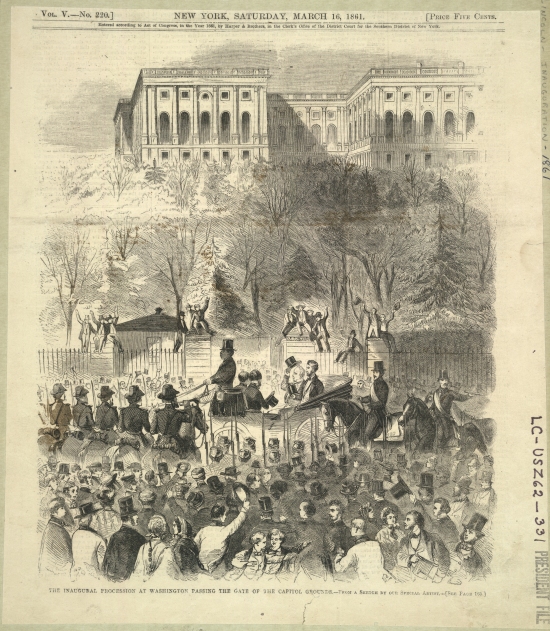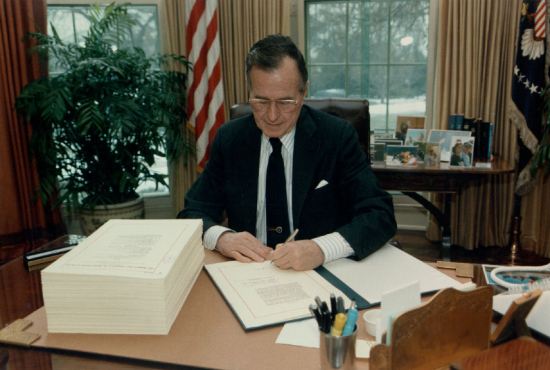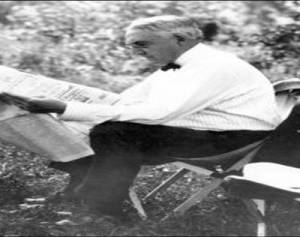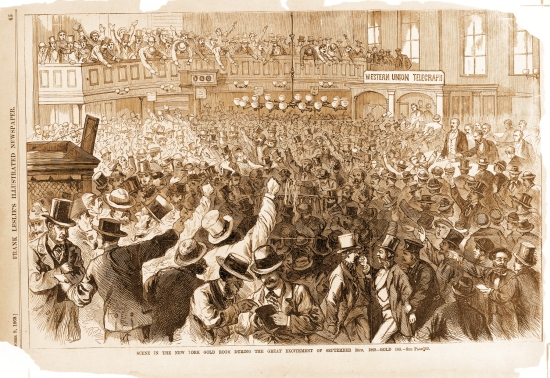— Portrait: Chester Alan Arthur’s inauguration, 1881
December 15, 2010 at 11:31 pm | Posted in -- Inauguration: Portraits, -- PRESIDENTS, Charles Guiteau, Chester Alan Arthur, James Garfield | Leave a comment Of all the presidential inauguration scenes of the late 1800s, my personal favorite is this one, a full-page cover from Leslie’s Illustrated showing Chester Alan Arthur taking the oath in the living room of his New York City townhouse. It took place at about 2:15 am on Tuesday morning, September 20, 1881, just hours after word reached Arthur by telegraph that President James A. Garfield had died, making Arthur a thoroughly accidental and reluctant chief executive. Arthur’s aides had to scour the neighborhood to find a judge — John R. Brady of the New York Supreme Court — to administer the oath.
Of all the presidential inauguration scenes of the late 1800s, my personal favorite is this one, a full-page cover from Leslie’s Illustrated showing Chester Alan Arthur taking the oath in the living room of his New York City townhouse. It took place at about 2:15 am on Tuesday morning, September 20, 1881, just hours after word reached Arthur by telegraph that President James A. Garfield had died, making Arthur a thoroughly accidental and reluctant chief executive. Arthur’s aides had to scour the neighborhood to find a judge — John R. Brady of the New York Supreme Court — to administer the oath.
The whole nation had been on a tense death-watch for Garfield ever since early July when Garfield had been shot in the back by a psychopath named Charles Guiteau at the Washington, D.C. train station. Garfield could have survived the gun shot, but his doctors had infected him by probing the wound with dirty fingers. During his struggle for life that summer, Garfield had become beloved in America, while Arthur was distrusted and feared.
Arthur never aspired to be President. His selection as candidate for vice president on Garfield’s 1881 ticket had been a political fluke — the product of a stalemated nominating convention. “A greater honor than I ever dreamed of attaining,” he called it. Known as Gentleman Boss for his role managing New York’s statewide Republican political machine, Arthur as vice president had openly opposed Garfield in the bitter argument over patronage and intra-party factions that had set the stage for Guiteau’s attack. As Guiteau was being arrested minutes after shooting the president, he announced: “I did it! I am a Stalwart, and Arthur will be President!”
These words by the assassin, coupled with Arthur’s role in the patronage fight, led many Americans to believe Arthur in fact was involved in the shooting. Arthur himself, a mild-mannered, dapper man, was horrified at the thought and dreaded the reaction if he took office. When told of Garfield’s death, Arthur broke down in tears. Look at Arthur’s eyes in the image above, (click to make it full size) and notice how the artist sought to capture the mix of fear, sadness, and determination.
If fact, once sworn in, Chester Alan Arthur became admirably independent. He surprised friends by signing the Pendleton Civil Service Act of 1883, the most important and successful government reform of the era. When old cronies came asking favors, he turned them away — often after bitter arguments. Said one: “He isn’t ‘Chet’ Arthur anymore; he’s the President.” Arthur guarded his privacy, telling one nosy temperance lady hectoring him about alcohol in the White House: “Madam, I may be President of the United States, but my private life is nobody’s dan business!”
Arthur’s admirable record won him no friends. His party refused to nominate him for re-election in 1884. That same year, he was diagnosed with Bright’s disease, a painful, then-uncurable kidney ailment that would kill him in late 1886.
Today, a century later, Chester Alan Arthur is largely forgotten. His name is the punchline to a dozen jokes about obscure dead presidents. I think this is shameful. Arthur, for all his faults, was also one of the most human and compelling presidents we’ve had, a flawed person who found integrity and grace in the most difficult circumstance.
— Portrait: Abraham Lincoln’s inauguration, March 1861
December 14, 2010 at 4:33 pm | Posted in -- Harpers Weekly, -- Inauguration: Portraits, -- PRESIDENTS, Abraham Lincoln, Civil War | Leave a commentAbraham Lincoln had little time to celebrate his inauguration as President of the United States on March 4, 1861. Already since his election the prior November, his country had crumbled. Seven states had seceded to form the Confederate States of America and inaugurated Jefferson Davis their president. War seemed likely. Lincoln himself literally had to sneak into Washington to avoid assassination plots. Soldiers guarded his every move. His former law partner Billy Herndon described Lincoln that day as “filled with gloomy forebodings of the future.”
Still, thirty thousand well wishers crammed into Washington for the swearing in that day. After a damp and cold morning, the sun broke through by the time Lincoln reached Capitol Hill. His inaugural speech, which he read while standing beneath the unfinished Capitol Dome, would be among his finest, and both the ceremony and the ball that night went off without a hitch.
The drawing here, a full-page panorama from Harper’s Weekly, shows Lincoln and outgoing President James Buchanan riding together to the ceremony, just reaching the foot of Capitol Hill. Buchanan tips his hat to the crowd. Click on the image to see it full size. Notice the double row of soldiers with bayonets lining the route, the cavalrymen leading the carriage. One soldier on a horse just behind the carriage holds a spyglass toward the crowd. Not seen here are the sharpshooters stationed in nearby windows and on rooftops, the soldiers patrolling side streets, and the additional infantrymen marching behind — all in case of trouble.
The pomp and ceremony seem so normal in this image, and give little sign of the carnage to come. Within a few months, war would come and, before it was over, over 600,000 soldiers North and South would die and countless thousands more would be crippled or maimed for life. But on this day, the transfer of power went smoothly, crowds could still cheer, politicians could still wave their hats, and people could still be happy.
— Portraits: James A. Garfield’s inaugural ball, March 1881
December 12, 2010 at 7:10 pm | Posted in -- CARTOONS AND CARTOONISTS, -- Inauguration: Portraits, -- Leslie's Illustrated, -- PRESIDENTS, Chester Alan Arthur, James G. Blaine, James Garfield, Roscoe Conkling | Leave a comment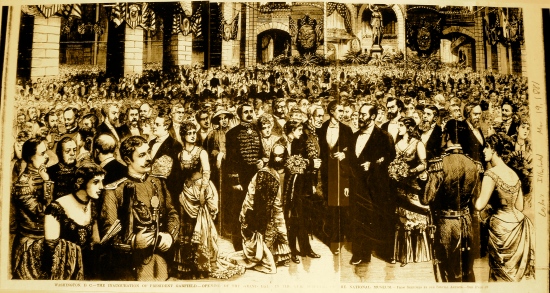 Here’s a snapshot I took recently of a rarely seen two-page spread from the Leslie’s Illustrated of March 19, 1881. It took a team of artists to sketch and then carve it by hand onto wooden block for printing. It shows the grand inaugural ball for President James A. Garfield, held in the Smithsonian Building that year. Garfield, a popular and moderate Ohio Republican, was doomed to serve only four months in office before a psychopathic hanger-on named Charles Guiteau shot him in the back as Garfield was entering the Washington, D.C. train station on a Saturday morning that July. Garfield would die from infection (yes, the doctors killed him by failing to wash their hands) a few months later on September 19, 1881. His assassination would shock the nation and make Garfield widely popular for a generation. There is hardly a town or city in America with a Garfield Street or two.
Here’s a snapshot I took recently of a rarely seen two-page spread from the Leslie’s Illustrated of March 19, 1881. It took a team of artists to sketch and then carve it by hand onto wooden block for printing. It shows the grand inaugural ball for President James A. Garfield, held in the Smithsonian Building that year. Garfield, a popular and moderate Ohio Republican, was doomed to serve only four months in office before a psychopathic hanger-on named Charles Guiteau shot him in the back as Garfield was entering the Washington, D.C. train station on a Saturday morning that July. Garfield would die from infection (yes, the doctors killed him by failing to wash their hands) a few months later on September 19, 1881. His assassination would shock the nation and make Garfield widely popular for a generation. There is hardly a town or city in America with a Garfield Street or two.
Click on the photo to blow it up and marvel at the detail. So accurate is the sketch that you can make out literally dozens of prominent faces in the crowd: Garfield, his wife Lucretia, Senators Roscoe Conkling, John Sherman, and Carl Schurz, plus incoming Vice President Chester Alan Arthur, incoming Secretary of State James G. Blaine, and a bevy of foreign diplomats. Look at the women’s gowns, the bunting on the walls, the guarded conversations. The band that night played tunes from the latest Gilbert and Sullivan operetta H.M.S. Pinafore — Garfield’s favorite. — that had premiered in London just two years earlier.
It’s a group portrait of a vanishing generation of politicians taken at a moment of graceful indulgence. Could any photograph or video have captured the moment so well?
— Portraits: President Grant’s inaugural ball, March 1869
December 11, 2010 at 7:02 pm | Posted in -- CARTOONS AND CARTOONISTS, -- Inauguration: Portraits, -- Leslie's Illustrated, James G. Blaine, Ulysses Grant | 2 CommentsTags: James G. Blaine, Ulysses Grant
 I love the way that old 1800s tabloids like Harper’s Weekly, Leslie’s Illustrated, and the others, long before photographs could be copied on newsprint, used artist’s sketches to capture dazzling visual scenes. The process was primitive and tedious by modern standards. Artists literally had to take their pencil drawings and carve them by hand onto wooden block or steel plates for the ink-slathered printing machines. But the results could be breath-taking, the first time many American’s in their lifetimes ever saw the faces of famous people, the insides of well-known buildings, or glimpses of how the other half lived.
I love the way that old 1800s tabloids like Harper’s Weekly, Leslie’s Illustrated, and the others, long before photographs could be copied on newsprint, used artist’s sketches to capture dazzling visual scenes. The process was primitive and tedious by modern standards. Artists literally had to take their pencil drawings and carve them by hand onto wooden block or steel plates for the ink-slathered printing machines. But the results could be breath-taking, the first time many American’s in their lifetimes ever saw the faces of famous people, the insides of well-known buildings, or glimpses of how the other half lived.
Here’s a nice one: A full-page panorama of the great gala inaugural ball thrown for Ulysses Grant, newly elected president of the United States, in the great chandeliered hall of the Treasury Department in March 1869. It appeared in Leslie’s Illustrated on March 20th that year, drawn by a young artist named James E. Taylor who earned his wings sketching battle scenes during the Civil War.
Click on the photo to see it full size. Look at the detail, the faces, the clothes, the room, and imagine the hours of labor it took to capture each line and nuance. The drawing is so accurate that you can make out individual faces in the crowd, not just President Grant and his wife Julia but also House Speaker James G. Blaine (standing behind Mrs. Grant’s shoulder), Senator Carl Schurz (over to the right), and several Civil War generals.
Photographs and videos are fine, but some of these artist sketches are true Pop Art masterpieces. Hope you like it.
Best statues in NYC’s Central Park: Poland’s King Jagiello, hero of 1410
December 6, 2010 at 11:49 pm | Posted in Uncategorized | Leave a comment
Six hundred years ago, this man atop his bronze horse in full battle regalia, pointing his dual sabers to the sky, was the single most powerful on earth. He was Poland’s King Wladyslaw Jagiello, and on July 15, 1410, he led an army of 50,000 Polish and Lithuanian knights, cavalry, and foot soldiers against a marauding horde of 32,000 invading Teutons — primarily Germans — near the small town of Grunwald.
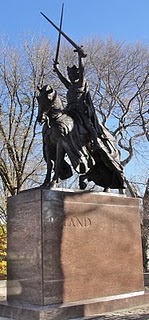 By sundown, Jagiello’s soldiers had slaughtered over 26,000 of the invaders, utterly demolishing their army. The Battle of Grunwald, as it came to be called, would reshape Central Europe for the next 300 years, placing King Jagiello in command of a vast, united Polish-Lithuanian empire that included large swaths of modern Germany and Russia. It was also one of the most civilized places in Medieval Europe, complete with bicameral legislature, checks on royal power, religious tolerance (this is when Jewish people came to escape persecution further west), and a home to Renaissance art. Jagiello’s vistory was one of two game-changing military events of the Fifteenth Century, the other being England’s 1419 triumph over France at Agincourt, immortalized by William Shakespeare in his play Henry V. (Click here to see Kenneth Branagh delivering Henry’s terrific speech to his troops.)
By sundown, Jagiello’s soldiers had slaughtered over 26,000 of the invaders, utterly demolishing their army. The Battle of Grunwald, as it came to be called, would reshape Central Europe for the next 300 years, placing King Jagiello in command of a vast, united Polish-Lithuanian empire that included large swaths of modern Germany and Russia. It was also one of the most civilized places in Medieval Europe, complete with bicameral legislature, checks on royal power, religious tolerance (this is when Jewish people came to escape persecution further west), and a home to Renaissance art. Jagiello’s vistory was one of two game-changing military events of the Fifteenth Century, the other being England’s 1419 triumph over France at Agincourt, immortalized by William Shakespeare in his play Henry V. (Click here to see Kenneth Branagh delivering Henry’s terrific speech to his troops.)Personally, I had never heard of King Jagiella (damn American education system!!) until last week when I happened to come across this fantastic statue of him in New York City’s Central Park. The
 work of Polish sculpter Stanislaw Ostrowski, it served originally as centerpiece for Poland’s exhibit at the 1939 New York World’s Fair. But the outbreak of World War II, in which Poland was quickly devoured by Nazi Germany and Stalinist Russia, left it stranded in America. New York Mayor Fiorello Laguardia fell in love it and lobbied to keep it in New York City. In 1945, the Polish government-in-exile agreed, and it was moved to its current spot in Central Park.
work of Polish sculpter Stanislaw Ostrowski, it served originally as centerpiece for Poland’s exhibit at the 1939 New York World’s Fair. But the outbreak of World War II, in which Poland was quickly devoured by Nazi Germany and Stalinist Russia, left it stranded in America. New York Mayor Fiorello Laguardia fell in love it and lobbied to keep it in New York City. In 1945, the Polish government-in-exile agreed, and it was moved to its current spot in Central Park.
Next time you’re in the neighborhood, don’t miss it. It’s at the east end of Turtle Pond, near the Great Lawn, not far from Cleopatra’s Needle, and an easy walk from the Upper East Side.
Best statues in NYC’s Central Park: Poland’s King Jagiello, hero of 1410
December 1, 2010 at 8:04 pm | Posted in -- POLAND, 1939 New York World's Fair, Battle of Agincourt, Battle of Grunwald, Fiorello LaGuardia, Henry V (King of England), Stanislaw Ostrowski, William Shakespeare, Wladyslaw Jagiello | Leave a comment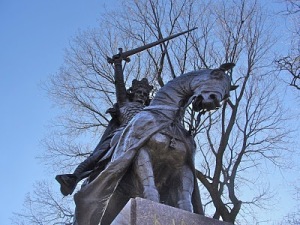
Six hundred years ago, this man atop his bronze horse in full battle regalia, pointing his dual sabers to the sky, was the single most powerful on earth. He was Poland’s King Wladyslaw Jagiello, and on July 15, 1410, he led an army of 50,000 Polish and Lithuanian knights, cavalry, and foot soldiers against a marauding horde of 32,000 invading Teutons — primarily Germans — near the small town of Grunwald.
 By sundown, Jagiello’s soldiers had slaughtered over 26,000 of the invaders, utterly demolishing their army. The Battle of Grunwald, as it came to be called, would reshape Central Europe for the next 300 years, placing King Jagiello in command of a vast, united Polish-Lithuanian empire that included large swaths of modern Germany and Russia. It was also one of the most civilized places in Medieval Europe, complete with bicameral legislature, checks on royal power, religious tolerance (this is when Jewish people came to escape persecution further west), and a home to Renaissance art. Jagiello’s vistory was one of two game-changing military events of the Fifteenth Century, the other being England’s 1419 triumph over France at Agincourt, immortalized by William Shakespeare in his play Henry V. (Click here to see Kenneth Branagh delivering Henry’s terrific speech to his troops.)
By sundown, Jagiello’s soldiers had slaughtered over 26,000 of the invaders, utterly demolishing their army. The Battle of Grunwald, as it came to be called, would reshape Central Europe for the next 300 years, placing King Jagiello in command of a vast, united Polish-Lithuanian empire that included large swaths of modern Germany and Russia. It was also one of the most civilized places in Medieval Europe, complete with bicameral legislature, checks on royal power, religious tolerance (this is when Jewish people came to escape persecution further west), and a home to Renaissance art. Jagiello’s vistory was one of two game-changing military events of the Fifteenth Century, the other being England’s 1419 triumph over France at Agincourt, immortalized by William Shakespeare in his play Henry V. (Click here to see Kenneth Branagh delivering Henry’s terrific speech to his troops.)Personally, I had never heard of King Jagiella (damn American education system!!) until last week when I happened to come across this fantastic statue of him in New York City’s Central Park. The  work of Polish sculpter Stanislaw Ostrowski, it served originally as centerpiece for Poland’s exhibit at the 1939 New York World’s Fair. But the outbreak of World War II, in which Poland was quickly devoured by Nazi Germany and Stalinist Russia, left it stranded in America. New York Mayor Fiorello Laguardia fell in love it and lobbied to keep it in New York City. In 1945, the Polish government-in-exile agreed, and it was moved to its current spot in Central Park.
work of Polish sculpter Stanislaw Ostrowski, it served originally as centerpiece for Poland’s exhibit at the 1939 New York World’s Fair. But the outbreak of World War II, in which Poland was quickly devoured by Nazi Germany and Stalinist Russia, left it stranded in America. New York Mayor Fiorello Laguardia fell in love it and lobbied to keep it in New York City. In 1945, the Polish government-in-exile agreed, and it was moved to its current spot in Central Park.
Next time you’re in the neighborhood, don’t miss it. It’s at the east end of Turtle Pond, near the Great Lawn, not far from Cleopatra’s Needle, and an easy walk from the Upper East Side.
Guest Blogger: Jim Robenalt on how HBO’s Broadwalk Empire flubbed its take on President Warren G. Harding
November 30, 2010 at 6:25 pm | Posted in Eugene Debs, Jim Robenalt, The Harding Affair, Warren G. Harding | Leave a commentHarding’s relationship with Nan Britton is questionable. His relationship with a woman named Carrie Phillips is not. My book, The Harding Affair, discloses Harding’s complex relationship with Mrs. Phillips through the use of over 900 pages of letters Harding wrote to Phillips from 1910 though 1920, when he was elected President of the United States. Phillips and Harding were caught in an age when divorce was unthinkable and there were multifaceted reasons for their long-term (15 year) affair. The affair was much too complicated to caulk it up sheer womanizing.
The Britton allegations are subject to real doubt, as I point out in my book. Ms. Britton lived directly behind Carrie Phillips’s home in Marion, and there is good reason to believe her book, The President’s Daughter, came from her familiarity with the Harding/Phillips correspondence and not because of any real relationship between then-Senator Harding and Ms. Britton.
The HBO series relies on biographies that falsely used the Phillips correspondence. Worse, letters Mr. Harding wrote to Mrs. Phillips are used to manufacture dialogue for Ms. Britton’s character.
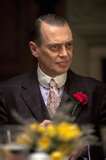 But sadly for history, these smears of President Harding distort what he did as President and as a U. S. Senator. Harding was no “imbecile,” as Nucky Thompson, the main character in the HBO series, calls him. As a Senator, Harding courageously stood against Woodrow Wilson’s call for America to go to war to “make the world safe for democracy,” though he did vote for war. In a lesson America never learned, Harding warned that it is not the business of the United States to engage in regime change through the violence of war.
But sadly for history, these smears of President Harding distort what he did as President and as a U. S. Senator. Harding was no “imbecile,” as Nucky Thompson, the main character in the HBO series, calls him. As a Senator, Harding courageously stood against Woodrow Wilson’s call for America to go to war to “make the world safe for democracy,” though he did vote for war. In a lesson America never learned, Harding warned that it is not the business of the United States to engage in regime change through the violence of war.
During his presidency, Harding pardoned Socialist Eugene Debs, who was rotting in an Atlanta prison, sent there by the Wilson Administration for violating the Espionage and Sedition Act.
Debs’ crime? He spoke out against the war—that is, he exercised his right of free speech. Wilson denied a pardon even after the war ended. Harding granted it.
Who is the “imbecile”?
Entertainment is entertainment. But playing fast and loose with serious historical figures only diminishes our true understanding of history’s lessons.
For a more, see http://thehardingaffair.com/.
Jim Robenalt, a lawyer and writer in Cleveland, Ohio, is author both of The Harding Affair and his other terrific book, Linking Rings, William W. Durbin, the Magic and Mystery of America.
$1,420 Gold: Headed for a Crash?
November 24, 2010 at 9:47 pm | Posted in Uncategorized | Leave a commentThis month, November 2010, saw the nominal price of gold blast itself into the record books with a historic new high of $1,420 per ounce, almost triple the price a decade ago. It’s been a remarkable run. Too good to be true?
Before gold bugs get too giddy, it’s worth remembering that this year also marks another anniversary, the 141st, of the darkest day ever in American gold trading: Black Friday (September 24) 1869, when the notorious corner by Jay Gould and Jim Fisk climaxed in a spectacular crash that crippled Wall Street for months, bankrupting thousands, freezing the national economy, and spewing scandal to the very door of the White House. It caused an estimated $100 million in financial value to vanish in a wink, worth multiple billions in modern money.
Still, 1869’s Black Friday was the ugliest, partly because both the price run-up and crash that year stemmed from the unabashed, garish actions two greedy speculators trying to enrich themselves at the expense of everyone else: James Fisk Jr. (below, left, in his ersatz “Admiral” uniform) and Jay Gould (below, right). 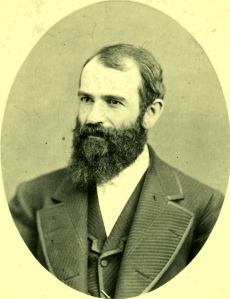
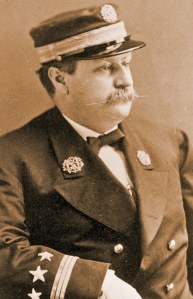
Fisk and Gould pulled off their famous gold corner decades before the battery of modern US financial regulators came on the scene: the SEC, CFTC, Federal Reserve, bank overseers, and even industry self-policing groups like FINRA or NFA. Fisk and Gould lost fortunes when the corner collapsed: Even back in 1869, the market was bigger than any two players, though it took the combined weight of the US Treasury announcing emergency gold sales and a pool of big banks dumping gold on the market to break their stranglehold.
Regulators can help, but commodities are notorious for volatility. Just two years ago, for instance, in 2008, we saw the price of a barrel of crude oil drop from nearly $150 in July to less than $34 in December, a whopping 75% loss, part of a sector-wide reversal.
Hello world!
November 24, 2010 at 9:31 pm | Posted in Uncategorized | 1 CommentWelcome to WordPress.com. This is your first post. Edit or delete it and start blogging!
Blog at WordPress.com.
Entries and comments feeds.
